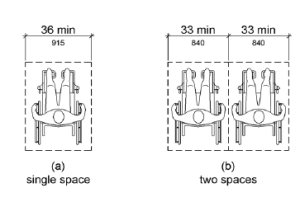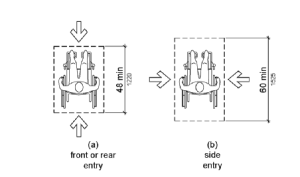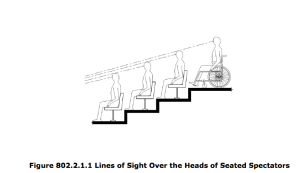The below regards the standards pertaining to ADA seating and is pulled directly from the US Government ADA Standards 2010
http://www.ada.gov/regs2010/2010ADAStandards/2010ADAstandards.htm
CHAPTER 8: SPECIAL ROOMS, SPACES AND ELEMENTS
801 General
801.1 Scope. The provisions of Chapter 8 shall apply where required by Chapter 2 or where referenced by a requirement in this document.
Advisory 801.1 Scope. Facilities covered by these requirements are also subject to the requirements of the other chapters. For example, 806 addresses guest rooms in transient lodging facilities while 902 contains the technical specifications for dining surfaces. If a transient lodging facility contains a restaurant, the restaurant must comply with requirements in other chapters such as those applicable to certain dining surfaces.
802 Wheelchair Spaces, Companion Seats, and Designated Aisle Seats
802.1 Wheelchair Spaces. Wheelchair spaces shall comply with 802.1.
802.1.1 Floor or Ground Surface. The floor or ground surface of wheelchair spaces shall comply with 302. Changes in level are not permitted.
EXCEPTION: Slopes not steeper than 1:48 shall be permitted.
802.1.2 Width. A single wheelchair space shall be 36 inches (915 mm) wide minimum Where two adjacent wheelchair spaces are provided, each wheelchair space shall be 33 inches (840 mm) wide minimum.
 Figure 802.1.2 Width of Wheelchair Spaces in Assembly Areas
Figure 802.1.2 Width of Wheelchair Spaces in Assembly Areas
802.1.3 Depth. Where a wheelchair space can be entered from the front or rear, the wheelchair space shall be 48 inches (1220 mm) deep minimum. Where a wheelchair space can be entered only from the side, the wheelchair space shall be 60 inches (1525 mm) deep minimum.
 Figure 802.1.3 Depth of Wheelchair Spaces in Assembly Areas
Figure 802.1.3 Depth of Wheelchair Spaces in Assembly Areas
Figure (a) shows a wheelchair space that can be entered from the front or rear that is 48 inches (1220 mm) deep minimum. Figure (b) shows a wheelchair space entered from the side that is 60 inches (1525 mm) deep minimum.
802.1.4 Approach. Wheelchair spaces shall adjoin accessible routes. Accessible routes shall not overlap wheelchair spaces.
Advisory 802.1.4 Approach. Because accessible routes serving wheelchair spaces are not permitted to overlap the clear floor space at wheelchair spaces, access to any wheelchair space cannot be through another wheelchair space.
802.1.5 Overlap. Wheelchair spaces shall not overlap circulation paths.
Advisory 802.1.5 Overlap. The term “circulation paths” used in Section 802.1.5 means aisle width required by applicable building or life safety codes for the specific assembly occupancy. Where the circulation path provided is wider than the required aisle width, the wheelchair space may intrude into that portion of the circulation path that is provided in excess of the required aisle width.
802.2 Lines of Sight. Lines of sight to the screen, performance area, or playing field for spectators in wheelchair spaces shall comply with 802.2.
802.2.1 Lines of Sight Over Seated Spectators. Where spectators are expected to remain seated during events, spectators in wheelchair spaces shall be afforded lines of sight complying with 802.2.1.
802.2.1.1 Lines of Sight Over Heads. Where spectators are provided lines of sight over the heads of spectators seated in the first row in front of their seats, spectators seated in wheelchair spaces shall be afforded lines of sight over the heads of seated spectators in the first row in front of wheelchair spaces.
Elevation drawing shows a person using a wheelchair on an upper level of tiered seating having a line of sight over the heads of spectators seated in front.
Lines of Sight Over the Heads of Seated Spectators
Figure 802.2.1.1 Lines of Sight Over the Heads of Seated Spectators
802.2.1.2 Lines of Sight Between Heads. Where spectators are provided lines of sight over the shoulders and between the heads of spectators seated in the first row in front of their seats, spectators seated in wheelchair spaces shall be afforded lines of sight over the shoulders and between the heads of seated spectators in the first row in front of wheelchair spaces.
Elevation drawing shows a person using a wheelchair on an upper level of tiered seating having a line of sight between the heads of spectators seated in front.
Figure 802.2.1.2 Lines of Sight Between the Heads of Seated Spectators
802.2.2 Lines of Sight Over Standing Spectators. Where spectators are expected to stand during events, spectators in wheelchair spaces shall be afforded lines of sight complying with 802.2.2.
802.2.2.1 Lines of Sight Over Heads. Where standing spectators are provided lines of sight over the heads of spectators standing in the first row in front of their seats, spectators seated in wheelchair spaces shall be afforded lines of sight over the heads of standing spectators in the first row in front of wheelchair spaces.
Elevation drawing shows a person using a wheelchair on an upper level of tiered seating elevated sufficiently to have a line of sight over the heads of spectators standing in front.
Figure 802.2.2.1 Lines of Sight Over the Heads of Standing Spectators
802.2.2.2 Lines of Sight Between Heads. Where standing spectators are provided lines of sight over the shoulders and between the heads of spectators standing in the first row in front of their seats, spectators seated in wheelchair spaces shall be afforded lines of sight over the shoulders and between the heads of standing spectators in the first row in front of wheelchair spaces.
Elevation drawing shows a person using a wheelchair on an upper level of tiered seating elevated sufficiently to have a line of sight between the heads of spectators standing in front.
Figure 802.2.2.2 Lines of Sight Between the Heads of Standing Spectators
802.3 Companion Seats. Companion seats shall comply with 802.3.
802.3.1 Alignment. In row seating, companion seats shall be located to provide shoulder alignment with adjacent wheelchair spaces. The shoulder alignment point of the wheelchair space shall be measured 36 inches (915 mm) from the front of the wheelchair space. The floor surface of the companion seat shall be at the same elevation as the floor surface of the wheelchair space.
802.3.2 Type. Companion seats shall be equivalent in size, quality, comfort, and amenities to the seating in the immediate area. Companion seats shall be permitted to be movable.
802.4 Designated Aisle Seats. Designated aisle seats shall comply with 802.4.
802.4.1 Armrests. Where armrests are provided on the seating in the immediate area, folding or retractable armrests shall be provided on the aisle side of the seat.
802.4.2 Identification. Each designated aisle seat shall be identified by a sign or marker.
Advisory 802.4.2 Identification. Seats with folding or retractable armrests are intended for use by individuals who have difficulty walking. Consider identifying such seats with signs that contrast (light-on-dark or dark-on-light) and that are also photo luminescent.
803 Dressing, Fitting, and Locker Rooms
803.1 General. Dressing, fitting, and locker rooms shall comply with 803.
Advisory 803.1 General. Partitions and doors should be designed to ensure people using accessible dressing and fitting rooms privacy equivalent to that afforded other users of the facility. Section 903.5 requires dressing room bench seats to be installed so that they are at the same height as a typical wheelchair seat, 17 inches (430 mm) to 19 inches (485 mm). However, wheelchair seats can be lower than dressing room benches for people of short stature or children using wheelchairs.
803.2 Turning Space. Turning space complying with 304 shall be provided within the room.
803.3 Door Swing. Doors shall not swing into the room unless a clear floor or ground space complying with 305.3 is provided beyond the arc of the door swing.
803.4 Benches. A bench complying with 903 shall be provided within the room.
803.5 Coat Hooks and Shelves. Coat hooks provided within the room shall be located within one of the reach ranges specified in 308. Shelves shall be 40 inches (1015 mm) minimum and 48 inches (1220 mm) maximum above the finish floor or ground.
